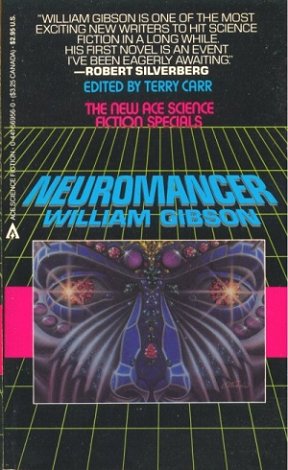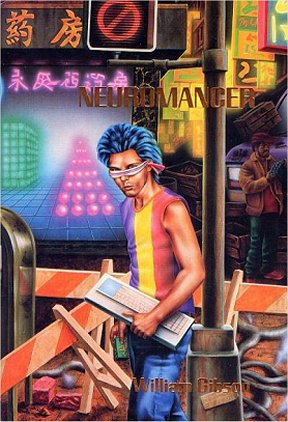

|
Cracking the Ice
|
|
Cyberpunk is by any measure one of Science Fiction's most successful neologisms. The word was invented (you might say stitched together like Frankenstein's monster) by Bruce Bethke for use as the title of his SF short story "Cyberpunk," which first appeared in Amazing Science Fiction Stories, Volume 57, Number 4, November 1983. |

|
In detailing the etymology of the word
"cyberpunk", Bethke tells the story of some teen punks who hacked the demo TRS-80 Model 1 at the Radio Shack where he worked in 1980. As a writer of SF, it inevitably occurred to him that:
The kids who trashed my computer; their kids were going to be Holy Terrors, combining the ethical vacuity of teenagers with a technical fluency we adults could only guess at. Further, the parents and other adult authority figures of the early 21st Century were going to be terribly ill-equipped to deal with the first generation of teenagers who grew up truly "speaking computer."
SF is often misunderstood to be purely a literature of prognostication, and older SF is often
unfairly judged in a harsh light because we didn't really have flying cars or robot butlers
by some arbitrary date. But the real value of SF is to function as a mirror for observers
(to hijack an Edgar Pangborn title); that is, SF really speaks more to the present than to
the future. At times the mirror magnifies some aspect of society, and sometimes it is a
funhouse mirror that distorts or exaggerates. Jack Finney's classic
Invasion of the Body Snatchers (1955) was not a story of alien invasion; it was a cautionary tale about the Communist threat and the rise of McCarthyism.
And so it was with the cyberpunk movement. The elements of cyberpunk were firmly rooted in cultural trends of the time, notably in the punk music scene that started in the 1970's with bands such as the Sex Pistols, the Ramones, and the Clash. In fact, the punk movement has been described as a counter-culture movement akin to the Beat Generation of the 1940/50's, which has in turn been likened to the Lost Generation of post-WWI Europe and America. Given the periodic nature of counter-culture resurgence, it was eminently logical for SF writers of the early 1980's to describe a future counter-culture movement set against a post-Information Revolution backdrop but mirroring the philosophy and style of the then-current punk scene.
Of course, Bethke himself is quick to point out that he did not invent the cyberpunk movement in SF:
... what I set out to do was to name a character type. And the primary definition of cyberpunk - the one that gets used in every news story about computer crime - is my definition: a young, technologically facile, ethically vacuous, computer-adept vandal or criminal.
The defining moment in the creation of cyberpunk as a literary subgenre is usually credited to
William Gibson, with the publication of Neuromancer (New York: Ace, 1984; ISBN 0441569560).
Issued as a paperback original in Terry Carr's legendary Ace Science Fiction Specials
(series 3), Neuromancer was an instant classic and the first novel to win the Hugo, Nebula, and Philip K. Dick Awards combined.
I was shocked to find upon researching this title that asking prices for first printings of this
Ace paperback original (in Very Good or better condition) have skyrocketed since I last checked:
there are currently only six copies listed through ABE, ranging from $250 to $635! The first
hardback appearance of Neuromancer is the UK edition (London: Gollancz, 1984),
which appeared after the Ace paperback edition. Asking prices currently range from
$830 to $1367 for three unsigned copies, and signed copies are consistently priced
above $2000. It should be noted that a signed Gollancz first in Fine/Fine condition
on eBay recently failed to attract any bids with an opening price of $1700. The first
US hardback publication was a signed, limited edition (West Bloomfield: Phantasia Press, 1986).
1575 copies were printed, the first 375 copies numbered and signed by the author in a specially
bound and boxed edition. A copy of the signed slipcased edition recently failed to sell on eBay
with a BIN of $700, stalling out at $385 with 11 bids. A signed copy of one of the 1200 trade
edition copies did recently sell on eBay for $256 with 16 bids. There is additionally an Easton
Press edition (Norwalk, Connecticut: Easton Press, 1990) that reliably sells in the $50 to $75
range. Finally, there are book club anniversary hardback editions - (Ace), 10th (Ace,
1994) and 20th (Berkley, 2004)- that should sell for $15+ in Fine/Fine condition.
That Gibson won the Philip K. Dick award for Neuromancer is particularly appropriate since
Dick is recognized as one of the literary predecessors to the cyberpunk movement.
His Do Androids Dream of Electric Sheep (New York: Doubleday, 1968; hardback, $5000+)
was filmed by Ridley Scott as Blade Runner in 1982, two years before the publication of
Neuromancer. Both the book and the film embody many of the themes and
stylistic elements of the cyberpunk aesthetic. The dark and gritty scenes of urban sprawl and
decay juxtaposed with the highest of technology; conflict between organic and artificial
intelligence, leading to a blurring of distinction between the two and uncertainty as to
just what it means to be human; the "Japanification" of Western culture; the rise
of the "megacorporations" as the true global power brokers; the fear of the loss of
individuality - all quintessentially cyberpunk. Other commonly cited literary precursors to
the cyberpunk subgenre include K. W. Jeter's Dr. Adder (New York: Bluejay Books,
1984; ISBN 0312940998, illustrated trade paperback $5; also ISBN 0312941005, signed
limited edition of 350, hardback with dustjacket in slipcase, $50 to $75); Greg Bear's
Blood Music (New York: Arbor House, 1985; ISBN 0877957207, $35 - $50; also Norwalk,
Easton Press, 1990; $50); and Alfred Bester's The Stars My Destination. Stylistic
predecessors include Raymond Chandler, William Burroughs, and film noir.
Questions or comments?
| Forum
| Store
| Publications
| BookLinks
| BookSearch
| BookTopics
| Archives
| Advertise
| AboutUs
| ContactUs
| Search Site
| Site Map
| Google Site Map
Store - Specials
| BookHunt
| BookShelf
| Gold Edition & BookThink's Quarterly Market Report
| DomainsForSale
| BookThinker newsletter - free
Copyright 2003-2011 by BookThink LLC


Contact the editor, Craig Stark
editor@bookthink.com
